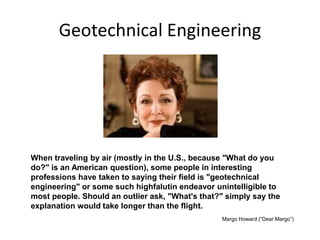Not known Details About Geotheta
Not known Details About Geotheta
Blog Article
Little Known Questions About Geotheta.
Table of ContentsHow Geotheta can Save You Time, Stress, and Money.The 9-Second Trick For GeothetaGetting My Geotheta To WorkGeotheta - Truths
They collaborate with civil engineers, architectural designers, architects, and various other specialists to integrate geotechnical factors to consider right into the general job style and building procedure. This needs effective synergy, coordination, and interaction to ensure that the geotechnical elements line up with the job goals and meet governing needs.Mining & Products Engineering: Principles of drilling, penetration rates, and variables impacting the choice of boring method. Qualities of dynamites, firing systems and blast patterns. Blowing up strategies in surface area and underground functions. Unique blowing up strategies at excavation borders. Resonance and sound control. Mechanical and continuous techniques to fragmentation, consisting of longwall shearing and fullface boring.
Modelling of piece and bit dimension distributions; comminution as a transfer feature. Comminution innovation: squashing, grinding, dimension classification. Integrated evaluation of fragmentation and comminution procedures. Used by: Mining & Products Design.
10 Easy Facts About Geotheta Explained
Bachelor's level programs in civil, geotechnical, geological, and ecological design commonly last four years and include general education courses in English, social science, and the humanities, in addition to programs in advanced maths, architectural geology, and fluid mineralogy. (https://disqus.com/by/geotheta/about/)
Geotechnical engineering includes the assessment of the soil and rock problems at a certain site, and their ramifications for the advancement of that website. As many frameworks depend on the ground for support, it is without surprise that an in-depth understanding of the ground problems, and the viability of structure systems, are crucial to the lasting security and efficiency of the building or framework.
Being experts in the investigation of geological formations and ground behaviour, geotechnical designers perform clinical investigations and testing to recognize the impact these geological formations may have on the layout and building of building, civil and framework tasks. This experience is crucial for the layout and building of structures, roadways, tunnels, dams, bridges, and water system and sewage systems.
The geotechnical group at Douglas Allies routinely seek advice from with engineers, style designers, developers, and building contractors to make suggestions on layout and development propositions to make certain that the constructed structures are suitably made for the ground conditions. The style of footing systems requires to think about the weight of the structure, the capability of the ground to support that weight together with motion resistances and effective building.
Not known Incorrect Statements About Geotheta
This task is considerably streamlined by the usage of our Douglas Map geospatial platform that makes this details conveniently accessible in a very easy to utilize internet browser user interface. A geotechnical engineer will route the drilling of boreholes and test pits to accumulate dirt and other samples, and additionally assess surface area attributes and ground direct exposures to create a geotechnical design of the subsurface problems.
Relying on the task type and ground problems ran into, laboratory testing may to name a few things examine strength, compressibility, reactivity and/or leaks in the structure of soil and rock samples. Hereafter information is collected and collected, the outcomes are made use of for a geotechnical design of the website, which is typically offered as sections across the website.

A geotechnical examination by nature can only assess the ground conditions at the locations drilled or excavated. Natural variations in dirt and rock conditions can happen throughout a site and in between test areas. It is as a result good method that the geotechnical designer be maintained throughout building of the job to provide on-site confirmation that the ground problems run into are regular with the expectations and advice provided in the geotechnical examination record.
Little Known Questions About Geotheta.
Geotechnical designers use their thorough knowledge of soil and rock to assess threat and resolve issues on varied infrastructure projectsGeotechnical engineering is a specialist branch of civil design which takes a look at the behaviour of planet materials and the application of soil and rock auto mechanics. Engineer of Record. As a geotechnical engineer, you will certainly assess the physical, mechanical and chemical residential properties of dirt and rock in order to create structures, keeping structures and earthworks
Geotechnical design is carefully linked to and overlaps with, both engineering geology and ground engineering - https://www.gaiaonline.com/profiles/geotheta/46779300/. It's feasible to specialise in geotechnics or benefit a geotechnical firm but be called an engineering geologist or a ground designer. As a geotechnical engineer, you'll need to: develop and keep connections with clients and various other experts involved in the website, throughout each projectmaintain safety and security standards on website be conscious of expense ramifications when you make recommendationsstudy geological maps and airborne photographs from a variety of resources and from various time periodsexamine construction plans to see exactly how practical they are based upon your understanding of the siteinvestigate dangers or geological hazards for the sitesearch for environmentally sensitive features, such as landfill start to create factual and expository ground modelsplan field investigationsdrill and analyse examples of bedrock, soil, groundwater and added materials monitor various other experts on sitesolve technical problems as they arise, such as unforeseen frameworks at drill sitesmonitor problems throughout and after construction to see to it structures are stable in the brief and lengthy termadding data accumulated on site to your initial researchcreating geotechnical estimations, drawings, and two or three-dimensional computer models analyzing the datamaking referrals concerning the recommended use of the site

Report this page